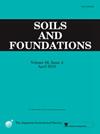含黏聚土中预埋悬臂墙地震永久位移预测方法
IF 3.3
2区 工程技术
Q2 ENGINEERING, GEOLOGICAL
引用次数: 0
摘要
在基于性能的设计方法中,地震引起的挡土结构永久位移的预测是关键的一步。对于基础较浅的挡土墙,通常采用著名的纽马克滑块法进行处理。然而,一些研究表明,这种方法不适合为地震荷载作用下预埋悬臂挡土墙的永久位移提供可靠的预测。为了克服这一缺点,本研究提出了一种实用的新方法来预测这些结构的地震引起的永久位移。在这种方法中,当地面加速度超过一个临界值时,墙体的运动是通过求解一个简单的运动方程来评估的。后一个值在地震事件期间通过计算作用在墙壁上的力,通过作者最近导出的封闭形式解来更新。该方法使用简单,需要的常规参数很少。这些特性使其适合当前的应用。为了评估本方法的预测能力,与文献中记录的离心机测试结果以及使用有限元代码解决的大量理想案例研究的结果进行了比较。讨论了减小墙体位移的一些措施的有效性。本文章由计算机程序翻译,如有差异,请以英文原文为准。
An approach for predicting earthquake-induced permanent displacements of embedded cantilever walls in soils with cohesion
Prediction of the earthquake-induced permanent displacements of retaining structures is a key step in the context of a performance-based design approach. For retaining walls with shallow foundations, this issue is usually dealt with using the well-known Newmark sliding block method. However, several studies have shown that this method is unsuitable to provide a trustworthy prediction of the permanent displacements undergone by the embedded cantilever retaining walls under seismic loading. To overcome this drawback, a new method of practical interest is proposed in the present study for a prediction of the earthquake-induced permanent displacement of these structures. In such a method, the wall movements are evaluated solving a simple equation of motion whenever the ground acceleration exceeds a critical value. This latter value is updated during the seismic event by calculating the forces acting on the wall by means of a closed form solution recently derived by the authors. The method is simple to use and requires few conventional parameters as input data. These features make it suitable for current applications. To assess the predictive capability of the present method, comparisons with the results of a centrifuge test documented in the literature and with those of a large number of ideal case studies solved using a finite element code, are presented. The effectiveness of some measures to reduce the wall displacements is also discussed.
求助全文
通过发布文献求助,成功后即可免费获取论文全文。
去求助
来源期刊

Soils and Foundations
工程技术-地球科学综合
CiteScore
6.40
自引率
8.10%
发文量
99
审稿时长
5 months
期刊介绍:
Soils and Foundations is one of the leading journals in the field of soil mechanics and geotechnical engineering. It is the official journal of the Japanese Geotechnical Society (JGS)., The journal publishes a variety of original research paper, technical reports, technical notes, as well as the state-of-the-art reports upon invitation by the Editor, in the fields of soil and rock mechanics, geotechnical engineering, and environmental geotechnics. Since the publication of Volume 1, No.1 issue in June 1960, Soils and Foundations will celebrate the 60th anniversary in the year of 2020.
Soils and Foundations welcomes theoretical as well as practical work associated with the aforementioned field(s). Case studies that describe the original and interdisciplinary work applicable to geotechnical engineering are particularly encouraged. Discussions to each of the published articles are also welcomed in order to provide an avenue in which opinions of peers may be fed back or exchanged. In providing latest expertise on a specific topic, one issue out of six per year on average was allocated to include selected papers from the International Symposia which were held in Japan as well as overseas.
 求助内容:
求助内容: 应助结果提醒方式:
应助结果提醒方式:


